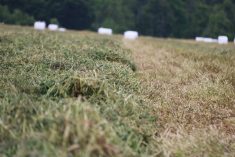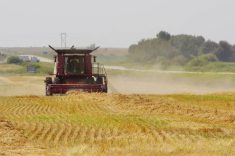espite all of mankind’s ingenuity, the weeds, it seems, always win in the end.
Monsanto once boasted Roundup-resistant weeds were “highly unlikely” to be found, but now strains of glyphosateresistant giant ragweed can be seen growing 18 feet tall in Ontario cornfields, and some biotypes of rigid ryegrass in Australia have become immune to virtually all chemicals.
Herbicide chemistry, originally developed during the Second World War to wipe out German potato crops, began to show its limitations in 1970 when the first resistant weed was found.
Read Also

Gene editing digs deeper space in Canadian plant breeding
More Canadian research into crop variety development is incorporating gene editing, and one researcher notes that Canada’s regulatory approach to gene editing will help drive innovation
It’s not the scientists’ fault – it’s just Mother Nature always wins, says international weed expert Ian Heap.
For example, in some rice fields in the Philippines that have been hand weeded for 80 years, barnyard grass has evolved to look just like young rice seedlings, said Heap, the Oregon-based director of the International Survey of Herbicide Resistant Weeds.
“They eventually selected a barnyard grass plant that was resistant to hand weeding,” said Heap. “They could no longer visually identify it. No matter what you do, evolution will find a way around it.”
The best approach is to vary weed control practices through integrated weed management, a combination of tank mixing chemicals with different modes of action, rotating herbicides, and using more diverse crop rotations to break cyclical patterns, Heap told attendees at the recent ManDak Zero-Tillage Association workshop.
So far, his organization has recorded 350 biotypes and 195 resistant weed species at half a million sites around the world. Not surprisingly, the greatest concentrations are in the developed world, where herbicides have been used the longest and most intensively.
“There’s about nine new herbicide- resistant weeds discovered every year,” said Heap.
The consequences include direct yield losses, reduced weed control options, spending more money on increased herbicide rates, and increased risk of residues polluting the environment, he added.
The biggest threat is weeds that have developed resistance to multiple herbicides in the same population, even when two or three modes of action are thrown at them simultaneously.
Canada is currently in third place in the “herbicide-resistant weed Olympics,” after the United States and Australia, with 51 biotypes, said weed-resistance researcher Hugh Beckie of AAFC Saskatoon.
Twenty-one resistant weeds have been identified in Manitoba, he added, and the top three are green foxtail, wild oats, and wild buckwheat.
Studies have found tank mixtures of more than one mode of action is more effective than rotating single herbicides in combating resistance.
“In our statistical analyses, growers that grow three or more crop types such as a cereal, oilseed and pulse or forage significantly lower their risk of resistance over just two crop types,” said Beckie, adding diversity helps to keep the weed population off balance.
After parking the sprayer, farmers who do in-field scouting of wild oat patches, for example, can follow up with patch treatments.
Glyphosate-resistant weeds have not been found so far in Manitoba. But Beckie predicted that in the brown and dark-brown soil region, kochia is likely to be the first, followed by wild oats and green foxtail.
“In the Parkland, I predict wild oats, then green foxtail
and cleavers,” he said, adding barnyard grass might join their ranks, too.
Beckie urged no tillers and direct seeders to visit www.weedtool.com, a Monsanto website that asks 10 questions about the crop production system used, and then provides a risk assessment.
“We haven’t really had a new herbicide mode of action in over 25 years, so we’ve got to use our existing herbicides more efficiently,” said Beckie.
Integrated weed management is the best defence, but he noted short-term economic needs sometimes trumps long-term concerns. Near his farm south of Saskatoon, growers chasing high prices have been growing Roundup Ready canola every other year.
“They are following the market, which is understandable, but certainly that could cause very high selection pressure,” he said.
daniel. winters @ fbcpublishing.com
———
“Theycouldnolonger visuallyidentifyit.No matterwhatyoudo, evolutionwillfind awayaroundit.”
– IAN HEAP














